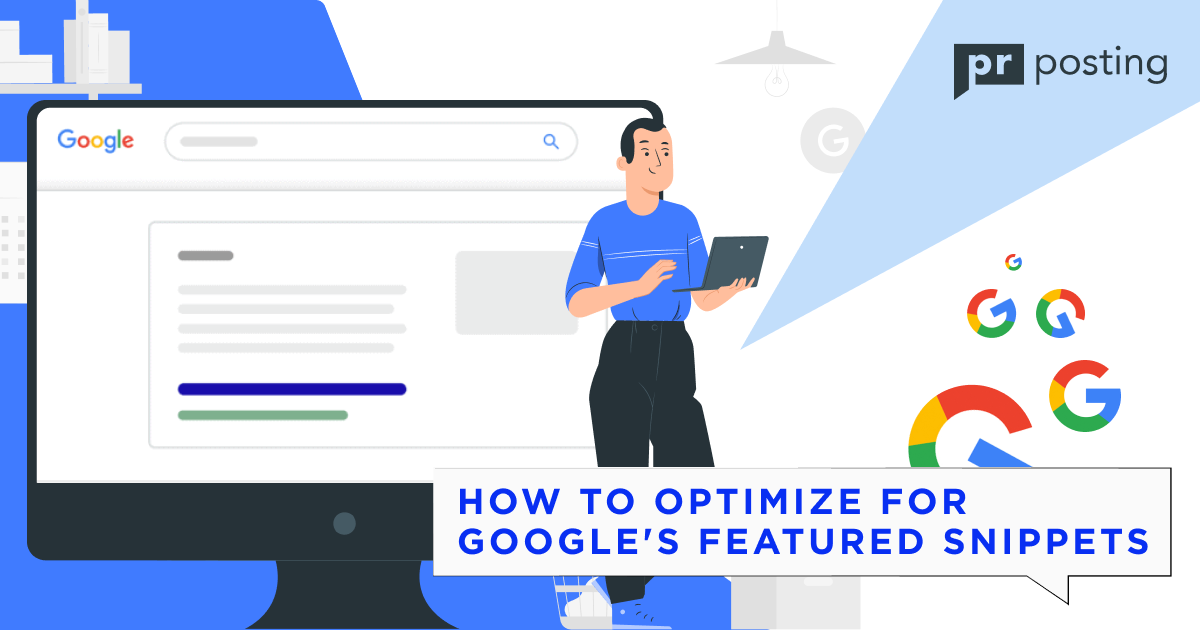How to Get Featured Snippets on Google

Types of featured snippets
A featured snippet is a block of quick responses that are shown in a special window at the zero position of organic search. It stands out from other answers with a frame and can contain text, lists, pictures, or videos. The search engine extracts it from the page automatically.
How a featured snippet is formed? The search algorithm extracts some of the information from one of the sites at the top, although it can very rarely take a site from the bottom leaving a link to the source, and displays it in the zero blocks.
How does this happen? The algorithm for the experiment selects a site and a snippet with good user metrics, after which it starts showing the selected snippet. If people stop going to the sites below and refining the search results, the fragment is working, and it remains in the zero position. If not, then the experiments continue: the algorithm will look for the answer on other sites.
Quick response fields or featured snippets have several varieties. It is important to know them to properly structure and optimize different types of content. The most common are the following formats.
Paragraph
This is the most common type. It shows the response to the user in text format, but it can also contain an image. Most often, such a snippet is found if you add the words when, how much, who, why, how, and similar to the search query.
The results are two or three sentences extracted from an HTML <p> element. A photo can also be added to the snippet, but this does not always happen. Even more rarely, a set of several pictures is displayed. This type of featured snippet is generated most often – up to 50%.
List
A bulleted or numbered list is the second most popular format, covering 37% of all reach descriptions.
A bulleted list is shown in cases where you need to list some items, but there is no fundamental difference in their order. Sometimes, the Google algorithm itself formats the list column headings into bullet points to display a summary of the page content in a block. Often, in this form, the characteristics and composition of the product are displayed.
A numbered list works similarly to a bulleted one, but in the case when the numbering matters, for example, in the instructions.
Table
An informational summary in the form of a table, extracted from the HTML <table> element. This type of snippet is the rarest.
There are other Google featured snippet formats, but we will limit ourselves to only these three.
How to get featured?
There is no special recipe for how to get into a featured snippet. However, there is a list of recommendations from experts in this area.
The easiest and most obvious way to get into a featured snippet is to create quality content and format it according to Google requirements.
Nevertheless, before you start optimizing existing content or preparing new one, you need to collect information about what keywords your competitors in zero results use. To do this, it is convenient to use Serpstat, Answer The Public services, and, in fact, Google itself.
Serpstat
On the main page of the service, you need to go to the tab in the left side menu that is called ‘Content marketing’ and click on ‘Search questions.’
By default, the data are grouped into several tables with different question words, which can be exported separately.
Answer the Public
If you need to collect interrogative phrases for the query ‘make pizza,’ use this service. Just enter the appropriate phrase in the line and click Get Questions.
The service can visualize the collected information in the form of a mind map. As a result, you get a fairly large pool of keywords that can be used for further work.
All selected phrases are clickable and lead to Google SERPs with the results for this query. Collected phrases can be downloaded and saved in CSV format.
One of the most effective and simple methods to find keywords by topic is to use search suggestions or the Google block, which is called Similar queries. This is a great free way to understand what information is being requested in a niche. The only negative moment is that it is quite time-consuming.
Furthermore, follow the rules:
- Instead of a series of articles, each of which will disclose only one question, it is better to create a large one with answers to all questions.
- The best structure for a Featured Snippet is a Q&A format. Try to structure the content in such a way that it provides answers to the maximum number of related questions in one article. According to experts, if a page is included in the block with answers for one request, there is a chance that Google will display it in the snippet for other related requests.
- Always divide content into H2 and H3 subheadings (one subheading should cover one issue). This will help the search engine.
- Under each subheading in the article, give the reader a concise and clear answer to their question that will fit the search intent (for example, if the user’s query requires detailed instructions, provide that first). Any details and additional information can be placed under the main text.
- The maximum size and volume of the quick response block are 370 characters with spaces. Try not to exceed this number; otherwise, the system will just cut off part of the text.
- Use keywords in the title (ideally, the entire keyword).
- Use bulleted lists for steps and tables for pricing information. The list, table, or subheadings with answers to the question should take up 70-80% of the total text. Simply inserting a list with a sequence of actions into any article will not be enough.
- Find or create original images that catch an eye of a client.
In 70% of cases, pages that are in the first three places in organic search results fall into the quick response block. In 25% of cases — pages from 4 to 10. In the remaining 5% of cases, Google pulls up the results from 11th to 70th place.
It would seem that what could be better than first place in search results when it is difficult for the user not to notice the link to your site? However, after all, if a person receives sufficient information on their request without unnecessary clicks on the link, why should they go further to the site? What kind of good traffic can we talk about then?
So, getting into the featured snippet has not only advantages but also disadvantages.
Let us start with the good points that the snippet provides:
- Specifying the site URL directly in the block.
- Organization reference. You specify the name of the organization directly in the text, which Google extracts in the response snippet.
- Use of the logo. Since many feature snippets contain a picture, you can add a watermark to it, which will increase brand awareness and can affect not only the amount of traffic but also the conversion.
Nevertheless, how a position in the zero block can harm you? Recently, the sites presented in this SERP element have been disappearing from organic search results. That is, if the site gets both at the top and in the extended answer, it is excluded from the organics — it cannot occupy two lines in the search results at once.
It is far from always that getting into the zero position gives the maximum CTR, which can lead to a drop in traffic. An example is requests with questions where a simple concise answer is needed, for example, when this or that event happened.
There is no guarantee that a block from your site will always be displayed. Depending on the reaction and behavior of users, the Google system may change the sources of information. In addition, if, according to Google statistics, it turns out that a fragment from your site is no longer useful, it may disappear from the snippet for good.
Optimizing content for featured snippets
What does Google say about how featured descriptions are selected? Predictable: there is nothing useful. Namely, they say that content can be shown in a featured snippet if it is relevant to the query and meets the quality criteria of the Google system. However, what exactly is the ranking mechanic, and how to sharpen the content to get into the zero position?
Let us find out the instruments that work well for this purpose.
Step 1. Subtitles and headings
Add the construction What is [keyword] in H2. The subheading itself should come first in the structure of the article and be located as close as possible to the beginning of the text. There are such examples where the subtitle immediately follows the table of contents. This is the first clear signal from Google that the text is a good candidate for a featured snippet. And that is the reason why the vast majority have this heading organization.
Step 2. Add it to the beginning of the first sentence
Let us move on from headlines to text optimization. Use the structure of the first sentence in the format: [keyword] is …
The structure of the introductory sentence should be as simple as possible. According to numerous observations, structuring content in this way works as a trigger phrase that allows Google algorithms to pick up candidates for ranking in the zero position.
Step 3. Expand the question in 2-3 simple sentences
The logic of the highlighted descriptions is based on offering users the most comprehensive answer in the most concise form. To meet these requirements, it is extremely important to be concise. Answer the question in two or three sentences. This is the most important rule to follow.
Sentences should have a simple structure and be easy to understand. From a grammatical point of view, it is better to use one-part sentences, without participial phrases, etc. This greatly increases the chances of breaking into the zero position. Although the algorithm can pull out the necessary fragments and assemble the text for the snippet from them, it is better to place the main sentences sequentially one after another.
In addition, it is important to adhere to a certain structure in the first 2-3 sentences. There are the following recommendations:
- The first sentence defines the topic and gives a short answer.
- The second and third sentences clarify and describe two or three facts, for example, how or for what the object is used.
- There should not be a single superfluous word in the definition. Priority is given to absolute conciseness.
Step 4. Optimize content for existing featured snippet formats
We have already said that there are several formats for featured snippets: paragraph, list, and table. The chances are high that you are not the first to claim a featured snippet for a particular query.
Therefore, first of all, check if there is a quick answer for the necessary keywords in the search results, and if so, remember which snippet formats Google generates for competitors. If a paragraph is used, optimize your text for a paragraph. If it is a list, make a list. If there is a table in the zero position, use the <table> tag on the page. Thus, you simply adapt to the already existing rich snippet format.
Step 5: Don’t use the brand name and spam environment
To get into the zero position, the text must be commercially neutral. First of all, it is necessary to abandon the mention of the brand and the occurrence of such words as buy, cheap, profitable, etc. This should not be forgotten by eCommerce sites that optimize the text on the page for a quick response. Alternatively, the brand can be registered in the Title. Practice shows that this does not affect getting into the zero position. The same is done with commercial spam keywords.
Step 6. Write texts in the third person
This rule continues the logic of the previous point — the text should be commercially neutral, and the first-person narration makes it personalized. If you are applying for a zero position, write the text as if from the outside.
Step 7: Analyze how Google generates listings — and do the same
Here, we are talking exclusively about bulleted lists, perhaps the most visible and clickable format for featured snippets.
As already mentioned, page optimization for featured snippets starts with SERP analysis. You need to break through the most often made request and see if a featured snippet is issued for it and, if so, in what format. The most interesting thing happens with bulleted lists. The listing that is displayed in the snippet is often not on the page — the algorithms generate it themselves. Your task is to carefully study the page, understand the logic of Google, and format your content in a similar way.
Observations show that most bulleted lists are generated from <h3> subheadings. However, there may be exceptions — for example, subheadings that are simply highlighted with the <strong> tag sometimes get on the snippet list.
Step 8. Bet on strong website pages
None of the above discounts the importance of fundamental SEO factors: the trust of the site and the quality of its optimization in other matters. In other words, the higher a site is in standard search results, the more likely it is to get to the zero position. This is important to remember when optimizing for a featured snippet. If you are improving old articles, first take those that occupy the top five results and perform the pool of work described above for them.
Step 9. If it doesn’t work the first time, try again — that’s okay
You optimized the strongest pages of the site and waited for reindexing but never got to the zero position — this is a normal scenario. We recommend not giving up but to keep making changes. As a rule, minor adjustments work very well. Try to formulate your answer more clearly, simplify the syntax and remove unnecessary words in the main sentences, and try optimizing for other snippet formats. Start with minor edits and move on to bigger ones.
It does not require a lot of effort and time. Often, breaking through to the zero position is obtained after three or four cycles of edits and reindexing.
Conclusions
The first thing a user sees in search results is a block with Google answers. Moreover, it’s not just a link to a website. Getting a featured snippet means that the site ranks in zero position, which is the highest possible position in the SERPs. Therefore, to reach this position, do the following:
- Start by determining what queries your competitors are getting snippets for.
- Google Suggestions and the Related Searches block will help you identify potential ideas for future content and collect the necessary semantics.
- Be sure to use as many related question keywords as possible in a single article.
- For each question, the answer should not exceed 50 words.
- Use subheadings to separate steps and lists.
While doing all these, you will definitely make your content better and discover new ideas for its creation. In addition, you can benefit from different featured snippet optimization tools. Thus, you will reach your goals and the desired ranking.
More Like This

Black Hat Link Building






